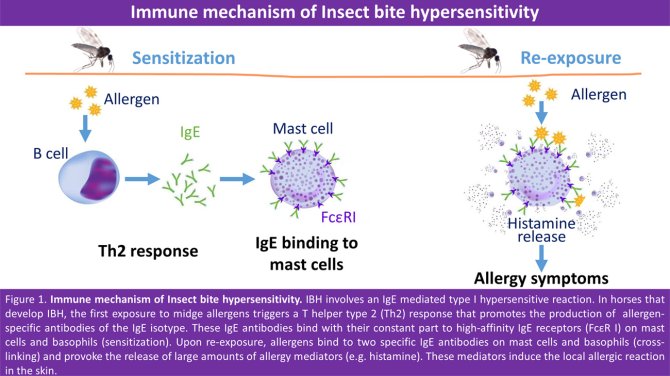
Project
Immunotherapies for insect bite hypersensitivity (IBH) in horses
Insect bite hypersensitivity (IBH), also known as summer eczema, is the most common skin allergy affecting horses worldwide. IBH is caused by the bites of (mainly) Culicoides obsoletus midges. In horses that develop IBH, the bites induce an allergic reaction with intense itch, swelling, hair loss and skin thickening. Self-inflicted wounds occur when horses scratch harshly.
Within our project we work on developing immunotherapies aiming to cure IBH, based on the understanding of the immune mechanisms behind this allergy.
Background
Insect bite hypersensitivity (summer eczema, sweet itch) is the most common allergic dermatitis compromising health and welfare of horses worldwide. IBH is caused by the bites of midges, mainly from the complex. In allergic horses, the bites of these midges induce an allergic reaction that results in intense itch, oedema, alopecia (hair loss) and lichenification (thickening) of the skin. Secondary wounds and even self-mutilation occurs when horses scratch to relieve their itch. Unfortunately there is no curative treatment for IBH.
IBH is a skin allergy that involves an IgE mediated type I hypersensitive reaction (Figure 1). In horses that develop IBH, the first exposure to midge allergens triggers a T helper-2 (Th2) type response that promotes the production of allergen-specific antibodies of the IgE isotype. These IgE antibodies bind with their constant part to high-affinity IgE receptors (FcεR I) on mast cells and basophils (sensitization). Upon re exposure to the allergen, the contact of this allergen with the allergen-specific IgE antibodies on mast cells and basophils provokes the release of large amounts of allergy mediators (e.g. histamine) that induce a local allergic reaction in the skin.

The project
Based on the immune mechanism behind this skin allergy, we design and test allergen specific immunotherapy strategies to modify the allergic response towards Culicoides obsoletusallergens into a non-allergic one, with the aim of curing horses allergic to these midges.
Publications
- Culicoides obsoletus extract relevant for diagnostics of insect bite hypersensitivity in horses. doi: 10.1016/j.vetimm.2012.07.007
- Evaluation of a diagnostic ELISA for insect bite hypersensitivity in horses using recombinant Obsoletus complex allergens. doi: 10.1016/j.tvjl.2013.12.004
- Recombinant Culicoides obsoletus complex allergens stimulate antigen-specific T cells of insect bite hypersensitive Shetland ponies in vitro. doi: 10.1111/vde.12251
- Component-resolved microarray analysis of IgE sensitization profiles to Culicoides recombinant allergens in horses with insect bite hypersensitivity. doi: 10.1111/all.14556
- Factors associated with Culicoides Obsoletus complex spp.-specific IgE reactivity in Icelandic horses and Shetland ponies. doi: 10.1016/j.tvjl.2014.04.023
- Genomic Regions Associated with IgE Levels against Culicoides spp. Antigens in Three Horse Breeds. doi: 10.3390/genes10080597